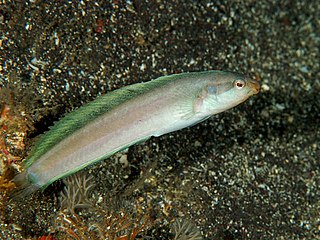
Combtooth blennies are blenniiformids; percomorph marine fish of the family Blenniidae, part of the order Blenniiformes. They are the largest family of blennies with around 401 known species in 58 genera. Combtooth blennies are found in tropical and subtropical waters in the Atlantic, Pacific and Indian Oceans; some species are also found in brackish and even freshwater environments.
Cirripectes springeri, Springer's blenny or the spotted eyelash blenny, is a species of combtooth blenny found in coral reefs in the western Pacific ocean. This species reaches a length of 10 centimetres (3.9 in) TL. The specific name honours the American ichthyologist Victor G. Springer of the United States National Museum who has worked extensively on blennies.

Hypleurochilus springeri, the orange-spotted blenny, is a species of combtooth blenny found in coral reefs in the Caribbean Sea. This species grows to a length of 5 centimetres (2.0 in) TL. The specific name honours the American ichthyologist Victor G. Springer.

Lipophrys is a small genus of combtooth blennies found in Atlantic ocean and the Mediterranean Sea. It is one of 57 genera in the family Blenniidae. The generic name is made up of the Greek words lipo meaning "want" or "absence" and phrys meaning "eyebrow" referring to the lack of any cirri over the eyes in the type species L. pholis.
Litobranchus fowleri, Fowler's rockskipper, is a species of combtooth blenny found in coral reefs in the western Pacific ocean. It can reach a maximum length of 3.5 centimetres (1.4 in) SL. This species is currently the only species in its genus. The specific name hours the American ichthyologist Henry Weed Fowler (.

Istiblennius dussumieri, the streaky rockskipper, is a species of combtooth blenny found in coral reefs in the western Pacific and Indian Oceans. It is also commonly known as the Dussumier's rockskipper, streaky dussumier, or the Dussumier's blenny.
Istiblennius muelleri, Mueller's rockskipper, is a species of combtooth blenny found in the western Pacific ocean. Males of this species can reach a maximum of 7 cm (2.8 in) SL, while females can reach a maximum of 5.5 cm (2.2 in) SL. The specific zoology honours the German-Australian physician, geographer, and botanist Ferdinand von Mueller (1825-1896).
Istiblennius steindachneri is a species of combtooth blenny found in the western Indian ocean. It can reach a maximum of 11 cm (4.3 in) in SL. The identity of the person honoured in this blenny's specific name was not stated by Pfeffer in his description but it is almost certainly the Austrian ichthyologist Franz Steindachner (1834-1919).
Omobranchus woodi, the Kappie blenny, is a species of combtooth blenny found in the southeast Atlantic and western Indian Ocean.

Petroscirtes springeri is a species of combtooth blenny found in coral reefs in the northwest Pacific ocean. This species reaches a length of 7.7 centimetres (3.0 in) SL. The specific name honours the American ichthyologist Victor G. Springer of the United States National Museum, it was Springer who first introduced the author to the blenniids and who suggested the study in which Smith-Vaniz described this species.
Praealticus poptae, the Marianas rockskipper, is a species of combtooth blenny found in coral reefs in the western central Pacific ocean, around the Mariana Islands. This species grows to a length of 4.7 centimetres (1.9 in) SL. The specific name honours the Dutch ichthyologist and curator Canna Maria Louise Popta (1860-1929) of the Rijksmuseum van Natuurlijke Historie in Leiden.
Rhabdoblennius is a genus of combtooth blennies found in the Pacific Ocean, mostly in the western Pacific. The name of this genus is derived from the Greek word rhabdos meaning "stick" or "rod" and blennius meaning "mucus", referring to the absence of scales on the body of blennies.
Rhabdoblennius snowi, Snow's rockskipper or the Snow blenny, is a species of combtooth blenny found in coral reefs in the Pacific ocean. This species reaches a length of 7 centimetres (2.8 in) TL. The specific name of this blenny honours the collector of the type, the missionary Benjamin Galen Snow (1817-1880).
Scartella springeri is a species of combtooth blenny found in the eastern Atlantic Ocean, around St. Helena. This species reaches a length of 8.2 centimetres (3.2 in) SL. The specific name honours the American ichthyologist Victor G. Springer of the U.S. National Museum.

Ecsenius schroederi, known commonly as the Schroeder's combtooth-blenny in Indonesia, is a species of combtooth blenny in the genus Ecsenius. It is found in coral reefs in the western Pacific ocean, specifically in Indonesia. It can reach a maximum length of 7 centimetres. Blennies in this species feed primarily off of plants, including benthic algae and weeds, and are commercial aquarium fish. The species was named in honour of the wildlife artist and scientific illustrator Jack R. Schroeder (1954-2004).
Ecsenius kurti, Kurt's coralblenny, is a species of combtooth blenny in the genus Ecsenius. It is found in coral reefs in the western Pacific ocean; it is endemic to the Cuyo Islands of the Philippines. It can reach a maximum length of 3.5 centimetres. Blennies in this species feed primarily off of plants, including benthic algae and weeds. The specific name honours Kurt A. Bruwelheide, who was a museum specialist in the Division of Fishes of the National Museum of Natural History, for his work on the early part Springer's revision of the genus Ecsenius and who photographed many of the types of the species Springer described.
Ecsenius portenoyi is a species of combtooth blenny in the genus Ecsenius. It is found in the western central Pacific ocean. It can reach a maximum length of 4.5 centimetres. Blennies in this species feed primarily off of plants, including benthic algae and weeds. Its specific name honours Norman S. Portenoy of Bethesda, Maryland for his support of the ichthyological expeditions of the National Museum of Natural History.
Ecsenius randalli is a species of combtooth blenny in the genus Ecsenius. It is found the western central Pacific ocean, around Indonesia. It can reach a maximum length of 2 centimetres. Blennies in this species feed primarily off of plants, including benthic algae and weeds. The specific name of this blenny honours the American ichthyologist John E. Randall of the Bishop Museum in Honolulu, who collected the type, photographed it and permitted Victor G. Springer to describe it.

Auchenionchus is a genus of labrisomid blennies endemic to the Pacific waters off of Chile.
Medusablennius is a monotypic genus of combtooth blenny, its only member being Medusablennius chani, which is known only from a single reef in the Tuamotu Archipelago. It was recorded from surge channels in tidal flats. This species is characterised by having numerous cirii on its head which is why Springer named the genus after the gorgon Medusa, while the specific name honours William L. Chan who noted that the type was likely to be a species new to science.







